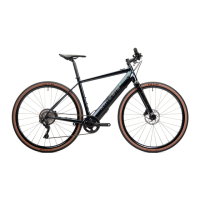GENERAL PRE-RIDE CHECK
• Check the connection between the handlebars and stem. Try pushing the handlebars
up and down - there should be no movement between these two elements. If there
is any, it is necessary to tighten the stem bolts, as shown in the ‘assembling your bike’
section.
• Check the headset for play (stand next to the bicycle, apply the front brake and push
forwards and backwards. There should be no play between the frame and fork). If any
play is found contact your local bike shop or If you are a condent mechanic, then adjust
this yourself. Follow these steps: Loosen the steer clamp binder bolts. Adjust pre-load
until no binding or looseness are present in the headset. Align the stem with the front
wheel and now tighten the steer clamp binder bolts alternately, in small increments.
Once again, check for headset play. If play exists, loosen the steer clamp, pinch bolts,
and tighten the top cap anchor bolt 1/16th of a turn. Align the stem, and re-tighten the
pinch bolts Remember to tighten both bolts alternately. Repeat until proper adjustment
made. All parts of the stem should be regularly checked for damage or cracks. If you nd
anything suspicious, contact an experienced bike mechanic immediately. Please do not
add or remove any spacers to adjust the height of the handlebar stem, as this will cause
the stem to be incorrectly tted. A defective steering system can cause serious injury or
death.
• Check if the wheels are straight (lift the bike and spin each wheel - the rim should not
move more than around 1 mm to each side). Check if all the spokes are tight by running
your hand around each wheel on both sides. Contact your bicycle dealer to resolve any
problems. Do not attempt to ride a bicycle with wheels that are not straight or with
spokes that are loose, as it is a danger to your health and life.
• Check if the tyres are properly inated (see the prints on the side walls for instructions
about the optimum pressure). Use a proper bicycle pump with a pressure gauge to
achieve the correct pressure.
• Check the overall conditions of the tyres, if they are damaged, torn or worn out you
should replace them before riding. Using worn or damaged tyres is dangerous to your
health and life. Make sure tyres are correctly inated and are in good shape. Spin each
wheel slowly and look for cuts in the tread and sidewall. Replace damaged tyres before
riding the bike.
• Do not ride if any defects are noticed!
• Check wheel axle to fork connection - this is critical for your safety.

